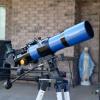
Doublet vs Triplet for Visual Use
#51

Posted 13 May 2010 - 12:11 PM
#52

Posted 13 May 2010 - 12:28 PM
And while the FS may show a bit of color inside and outside of focus, as far as I can tell, visually, in focus, the FS shows almost perfect color correction.
And this statement makes the most sense, because who among us views out of focus?
#53

Posted 13 May 2010 - 12:45 PM
Color correction depends on the focal ratio and aperture of the telescope. For a given design, the scale factor is the focal ratio/aperture. This means as you scale up a particular doublet design, you either increased the focal ratio proportionally to the increase in aperture or you accept a reduced level of color correction.
When you look at what is available, typically 80mm refractors are doublets, a few triplets, some made with ED glasses with lower Abbe Numbers.
At 4 inches, fast triplets show up at the high end, doublets remain in slower focal ratios that 80mm F/7 doublet that offers very good correction becomes an 100mm F/9 that offers very good color correction.
The larger the aperture, the more desirable a triplet becomes if one wants to maintain a color free view.
The differences can be seen visually as has been mentioned... If you want to really test the color correction, Venus is currently well positioned in the early evening. The NP-101 seems to have color correction that is like a reflector, inside and outside of focus there is nothing to my eye. Other designs may offer lesser levels when viewing the ultra challenging Venus.
Is this a big deal?
I guess that is for each of us to decide.
One could always just settle for a good quality Newtonian and be done with it. My C4.5 does a wonderful job on Venus...
Jon
#54

Posted 13 May 2010 - 12:58 PM
On the other hand, I could use an FS-128 all night and not really pay attention to the level of false color it produces, but if I am moving between an A-P 130EDT and a FS-128, I will notice the chromatism in the FS-128. Having a better-corrected reference point makes it more noticable too.
I've yet to see enough false color in any FS-series scope for it to be bothersome. I have seen false color in slow achromats that I felt crossed the "bothersome" threshhold. Other folks have different sensitivity to and/or tolerance for chromatism.
Regards,
Jim
#55

Posted 13 May 2010 - 12:58 PM
Image of artificial stars, 300x, Sky-Watcher Equinox 120 ED doublet.
Looks pretty similar.
(Disclaimer!
Some Equinox 120's might be better than others.
Contact your local optics tester for details.
Yes, the Zeiss *is* better.
#56

Posted 13 May 2010 - 01:57 PM
If one is doing terrestrial viewing, it could be important.And while the FS may show a bit of color inside and outside of focus, as far as I can tell, visually, in focus, the FS shows almost perfect color correction.
And this statement makes the most sense, because who among us views out of focus?
#57

Posted 13 May 2010 - 02:07 PM
russel23 nailed it in his reply above. Oil transmits heat more effeciently than air. However you would need to actually do a thermal analysis to find out if an oiled triplet would cool quicker than an air spaced doublet. Mass is also a very important quantity.
Many thanks to all the posters explaining on the "cooling down time". Most experiences and the physical/thermodynamic explanations given here on cooling down give priority to oil-spaced triplets. I now understand why.
But I also think that the rear element (of doublets or triplets) is almost entirely hindered because of the air in the tube. If nevertheless the tube material allows quick thermal exchange with the outside air (or if warm air escapes or is refreshened half an hour before observing because of leaving the focuser "open"), I suppose it may help the rear element not only to cool down "through" the front element (air-spaced) or through the oil-spaced medium and the front element.
Whether air- or oil-spaced, it seems that thermic conduction of the tube and the cell ought to be very high (or insulating power very low) in order to optimize cooling down.
If for backyard astronomers with more than half of the year of fine observing conditions, this is of less importance, I can swear that if one lives in awful meteorological conditions as myself, each quarter of an hour more or less observing time IS important and precious.
Another concern I had with oil-spacing (I also found oil-spacing on second-hand Lichtenknecker APOs) was the reliability in the long term: how about oil-leaking risks? about appearing of bubbles? about physical or chemical alteration of the oil substance with the years likely to affect the optical performance?
Any comments about this?
Thanks.
#58

Posted 13 May 2010 - 02:09 PM
Bob
#59

Posted 13 May 2010 - 02:18 PM
Stop thinking color and start thinking information. Jupiter is sending you information - do you what the complete message or just a portion?
Bob
Hey Bob.
I wish Jupiter would stop sending me information about timeshare condos on Europa.
(p.s., understood what you're suggesting {seriously speaking}
#60

Posted 13 May 2010 - 02:24 PM
Sedat
#61

Posted 13 May 2010 - 02:34 PM
Sensitivity to CA is not the issue. It matters not whether you can or can’t see the CA because if it’s there it’s there. Stop thinking color and start thinking information. Jupiter is sending you information - do you what the complete message or just a portion?
Bob
but some people's eyes can't see the purple/blue colors, they're getting filtered out because of aging or other reasons. so if you're not seeing the purple it's not going to blur the image
#62

Posted 13 May 2010 - 02:50 PM
If the tube is an important element in transferring the heat, I assume we must avoid Carbon Fiber tubes ? What do you think ?
Sedat
Honestly, no experience or knowledge about this. I only read (I don't remember the source) that carbon tubes are poor cooling performers but as I have no carbon tube, I cannot confirm.
But if confirmed, the worse would be: medium or big air-spaced triplets in carbon tube.
May be if you drill some dozens of holes in the tube, cooling down may progress faster.
Another way around: put your scope half an hour in your wine cooler before observing (11-14 C°).
#63

Posted 13 May 2010 - 03:04 PM
I believe the physics would suggest that it is indeed somewhat of an insulator, so in that particular respect, perhaps less than desirable in a refractor OTA for use cases where one needs as rapid as possible a cool down.
but...
My experience showed me that it maintains dimensional stability ACROSS changing temperatures very, VERY well. For visual uses, a total non issue; for AP a not inconsequential benefit.
I could literally focus my OTA ONCE per night and be done...
More to the main thread here; intellectually the oil/triplet cooling faster makes sense to me... but, no hard data/experience.
clear enough skies
#64

Posted 13 May 2010 - 03:12 PM
Sedat
#65

Posted 13 May 2010 - 03:17 PM
I guess that your R200SS was a reflector that is largely open in front.
Anyway in more or less hot summers, the scope has often reached temperatures very near to outside temperature: no important cool down needed any more.
But according what you say, the variation of night temperature either needs a very temperature stable configuration for astrophotography (I do not practice), or a scope that adapts as fast as possible for visual.
#66

Posted 13 May 2010 - 03:32 PM
For either the oil or airspaced designs a large portion of the cooling of the inner elements comes from conduction from the edge. As the edge cools it introduces a change in figure of the outer portion of the lens. For an airspaced lens, this changes the ray path and the lens acts as if it’s under-corrected. With ED glasses and their fairly high coefficients of thermal expansion, the degree of wave front error that introduces in an airspaced design can make the lens useless for high resolution work until things have thermally stabilized.
However, since an oil spaced lens acts like a single block of glass with no air gaps, the design is very insensitive to changes in the internal radii due to the progressive cooling from the edge. As such the oil spaced lens has a better wave front figure than that of an airspaced lens during the cooling process and can typically be used at higher powers much quicker than an airspaced design.
And this has been exactly my experience in owning both designs and having side-by-side comparisons.
Of course, an oiled lens is still a big chunk of glass giving off heat and you will get plumes, tube currents and the other usual suspects associated with cooling optics.
Jeff
#67

Posted 13 May 2010 - 04:47 PM
Clear skies, Alan
#68

Posted 13 May 2010 - 10:58 PM
I wish Jupiter would stop sending me information about timeshare condos on Europa.
And that Clive is why there are such things as tin foil hats! Blocks that kind of stuff pretty well I understand.
#69

Posted 14 May 2010 - 07:00 AM
I wish Jupiter would stop sending me information about timeshare condos on Europa.
Clive you crack me up!!
#70

Posted 14 May 2010 - 07:04 AM
Jim
#71

Posted 14 May 2010 - 09:44 AM
The long achro seems more 3-D.
#72

Posted 14 May 2010 - 10:36 AM
#73

Posted 14 May 2010 - 11:17 AM
Jim, this is what I see when using a long achro vs a short apo.
The long achro seems more 3-D.
When using one eye, the 3-D impression has a great deal to do with how our eye and mind work and essentially nothing to do with what type of telescope you use. I don't even think you could come up with a reasonable suggestion to explain why one telescope would look more 3D than another. My lunar views are starkly 3D through an apochromat or a Newtonian, as is Saturn.
I think the secondary color in a large achromat actually detracts from that 3D experience.
Clear skies, Alan
#74

Posted 14 May 2010 - 11:24 AM
"Doug76 Long Achro Junkie" - I like it. I like it! 3-D and APO-free


I've been-APO free since I was discharged from the army in March of 1972. It has been a good feeling.
I've had a nice apochromat since 1988, and that has also been a good feeling.
Clear skies, Alan
#75

Posted 14 May 2010 - 11:31 AM
Jim, this is what I see when using a long achro vs a short apo.
The long achro seems more 3-D.
When using one eye, the 3-D impression has a great deal to do with how our eye and mind work and essentially nothing to do with what type of telescope you use. I don't even think you could come up with a reasonable suggestion to explain why one telescope would look more 3D than another. My lunar views are starkly 3D through an apochromat or a Newtonian, as is Saturn.
I think the secondary color in a large achromat actually detracts from that 3D experience.
Clear skies, Alan
Like Alan sez, who knows what's responsible for a "3-D" impression when looking with one eye...
But, I can say what isn't.
60mm refractor at 525x, trying to view the Moon.
This happened back in 1973.
Couldn't even see the Moon at the time, so it constituted a 0-D experience.
Those weren't the days...



























